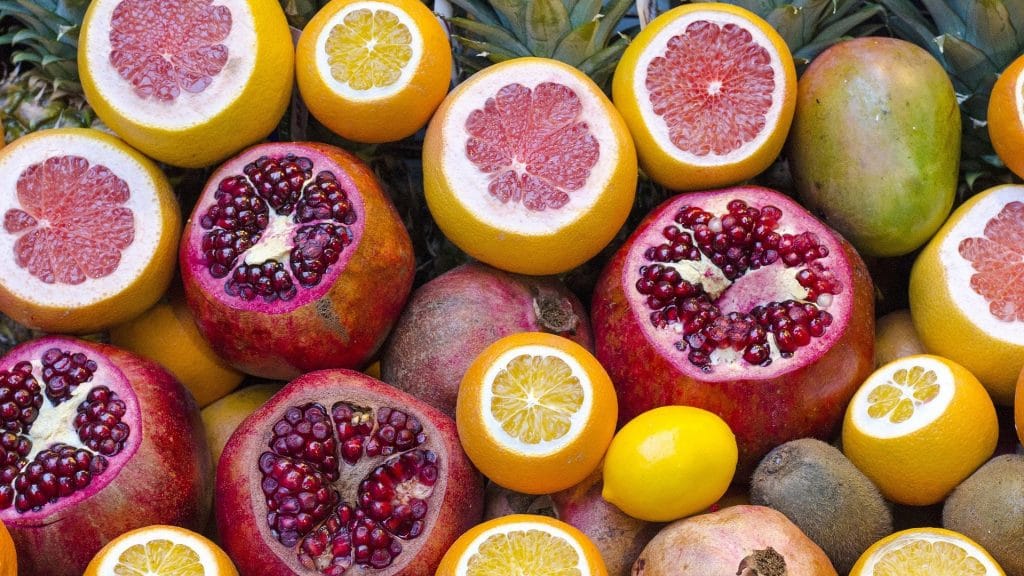25 Vitamin C Foods That Will Boost Your Immune System

Vitamin C is one of 13 essential vitamins, which all have many vital functions in our body. Besides being a powerful antioxidant, vitamin C is critical for maintaining our immune system healthy and strong. Since our body cannot produce this vitamin, we need to consume enough vitamin C foods daily.
What’s great is that there are plenty of foods high in this vital nutrient, and here we will provide you with a list including some of the richest sources. Remember that to stay healthy, you need to follow a balanced diet rich in protein, minerals, vitamins, and other nutrients.
What Is Vitamin C?
Vitamin C, also known as ascorbic acid, is a water-soluble vitamin, which means that our body doesn’t store it. It is carried through the bloodstream, and all the excess amounts are excreted in the urine. It plays numerous essential roles in our organism, including an antioxidant function, so we need to take it regularly through food and sometimes supplements. Moreover, vitamin C is involved in the biosynthesis of collagen, which contributes to wound healing. It also takes part in protein metabolism and the biosynthesis of neurotransmitters.
What Does Vitamin C Do?
One of the well-known functions of vitamin C is the one related to boosting the immune system. Another one of the ascorbic acid benefits is that it is crucial for producing white blood cells, which fight against foreign invaders causing infections. In addition, it protects them from free radicals, making them more effective. Another one of the benefits of vitamin C is to help the body absorb iron from plant-based foods. This way, it can prevent iron deficiency and anemia.
Many people take a vitamin C supplement to treat a common cold. However, according to a study on preventing and treating a cold with vitamin C, it’s not effective if taken when the first cold symptoms appear. On the other hand, there is some evidence that vitamin C may reduce the duration of a cold and make it less severe. There are also benefits of vitamin C serum related to our skin. They include:
- reducing wrinkles
- wound healing
- skin tone evening
- complexion brightening
“Does vitamin C actually help?”—many ask. Well, there are numerous studies on the role of vitamin C in preventing and treating more serious diseases, including:
- various types of cancers
- age-related macular degeneration
- cataracts
- heart disease
Still, more research needs to be done to prove that vitamin C can help treat these medical conditions.
Ascorbic Acid Food
Various foods contain different amounts of vitamin C. However, the best source of vitamin C is fruits and vegetables. In addition, some brands enrich breakfast cereals with vitamin C as grains typically don’t contain this nutrient. It’s also important to mention that prolonged storage and cooking decrease vitamin C content in food since it is water-soluble and heat-sensitive.
Therefore, it’s a good idea to prepare food by steaming or microwaving, or even better, eat fresh fruit and vegetables. Here you can find a list of vitamin C foods and drinks. So try to include them in your diet and reap the benefits of this precious nutrient.
Red Sweet Peppers
Red sweet peppers are vitamin C foods. In fact, half a cup of raw peppers provides you with 106% of this vitamin’s DV. What’s more, this veggie is rich in other vitamins, including vitamin E, vitamin A, vitamin B6, and folate, and they support the immune system and improve eye and skin health.
Green Sweet Peppers
Green sweet peppers prove you can find ascorbic acid in food in high amounts. With just half a cup of raw peppers, you can completely cover 67% of the vitamin’s DV. So, instead of taking vitamin C tablets, try eating more veggies like sweet green peppers. They are rich in other vitamins as well, such as vitamins A, B6, and K.
Broccoli
Broccoli is another one of vitamin C vegetables. In order to consume more vitamin C, it’s better to eat it raw than to cook it. Namely, one cup of raw broccoli contains 90% of the vitamin C’s recommended DV. On the other hand, half a cup of cooked broccoli has 57% of the DV. Moreover, the same amount of cooked broccoli will also give you 26% of vitamin B9 DV.
Brussels Sprouts
Besides broccoli, vitamin C is found in Brussels sprouts. They’re a great source of this nutrient as half a cup of cooked Brussels sprouts can provide you with 53% of the C vitamin’s DV. Moreover, they are high in vitamin K and fiber, and they are known to help maintain healthy blood sugar levels.
Tomato Juice
Another ascorbic acid food. Namely, if you drink one cup of this juice, you will cover 74% of your DV. In addition, you can eat raw tomatoes as they are also rich in vitamin C. For example, one medium tomato contains 19% of this vitamin’s DV. Furthermore, tomato juice is high in potassium and B vitamins and may lower inflammation and risk some cancers and heart disease.
Cabbage
Cabbage is also one of the high vitamin C foods. Notably, in half a cup of cooked cabbage, you can get 31% of the vitamin’s recommended DV. Furthermore, this vegetable is a fantastic source of folate, vitamin K, vitamin B6, manganese, and potassium. It also helps with digestion, lowering blood pressure, keeping your heart healthy, and lowering cholesterol levels.
Cauliflower
Cauliflower is part of the vegetables with vitamin C, and it is rich in various vitamins and minerals. As a matter of fact, half a cup of raw cauliflower contains 29% of this vitamin’s DV. Also, it is an excellent source of vitamin K, folate, and vitamin B6. When it comes to minerals, it is a good source of potassium and manganese.
Potatoes
Potatoes are another veggie that belongs to foods with vitamin C, as one medium baked potato can provide you with 27% of the vitamin’s DV. Potatoes are also rich in B vitamins, including niacin, vitamin B6, folate, and thiamin. In addition, they are rich in potassium and manganese.
Green Peas
Vitamin C foods include green peas, too. For instance, half a cup of cooked green peas gets you 10% of the C vitamin’s DV. In addition, they are a good source of zinc, vitamin E, and other antioxidants. Therefore, they help with inflammation and lower your risk of diabetes, arthritis, and heart disease.
Parsley
Parsley represents another ascorbic acid food, as a cup of parsley gets you approximately 133% of the C vitamin’s DV. Additionally, it is exceptionally high in vitamins K, C, and A and can improve bone health, provide antioxidant benefits, and protect against specific chronic diseases.
Mustard Greens
Vitamin C foods list uncovers that mustard greens are a fantastic source of vitamin C, especially if eaten raw. In fact, one cup of chopped raw mustard spinach serves 217% of this vitamin’s DV. Moreover, it’s a rich source of vitamin A, folate, and various minerals, including calcium, manganese, potassium, and iron.
Scotch Kale
Scotch kale is another green veggie belonging to foods high in vitamin C. As a matter of fact, with one cup of cooked and chopped Scotch kale, you get 88% of the vitamin’s DV. This type of vegetable is also high in vitamin A. Among other minerals, it contains magnesium, manganese, calcium, and iron.
Cantaloupe
Cantaloupes are foods that contain ascorbic acid, too. With just half a cup of cantaloupe, you can cover around 54% of this vitamin’s DV. Moreover, it is an excellent source of vitamin A. It also protects your cells from damage, keeps your skin, eyes, bones, and immune system healthy.
Honeydew Melon
Honeydew melon is another sort of melon that belongs to vitamin C–rich foods. Namely, one cup of honeydew melon serves 53% of the C vitamin’s DV. In addition, it is an excellent source of potassium, and it may lower blood pressure, improve blood sugar control, support healthy skin, and help with digestion.
Orange Juice
Orange juice is an excellent choice from vitamin C drinks. Namely, ¾ of a cup of this refreshing juice contains around 103% of the vitamin C’s DV. It’s also a great source of thiamin, folate, and vitamin A. On the other hand, one medium orange gives you about 78% of your DV.
Guavas
Many people presume that lemons and oranges are the richest sources of vitamin C. However, this is not true. So which fruit has more vitamin C than an orange? Among others, guavas have a higher vitamin C content than any other more commonly available citrus fruit. From one guava fruit (without refuse), you will get 140% of the vitamin’s DV.
Pink Grapefruit juice
Pink grapefruit juice is one of the good sources of vitamin C. In other words, If you drink one cup of this fruit juice, you will cover 104% of your DV of this healthy nutrient. And if you eat half a medium pink grapefruit, you will cover 43% of the vitamin’s DV. Furthermore, grapefruit juice is considered to help with weight loss, blood pressure, and heart health.
Kiwi Fruits
Kiwi fruits are one of the highest vitamin C foods as one kiwi fruit provides you with 78-106% (depending on the size of the fruit) of this vitamin’s DV. This type of fruit is also a rich source of vitamin K, vitamin E, potassium, and copper. What’s more, kiwi offers plenty of health benefits—it helps with digestion, blood pressure, and heart health and prevents stroke and heart disease.
Strawberries
Strawberries are vitamin C fruits since half a cup of fresh and sliced strawberries can provide you with 53% of the vitamin C’s DV. This type of fruit also contains various essential minerals while exceptionally high in manganese and magnesium. Additionally, strawberries may lower the chances of diabetes, heart disease, cancer, and stroke.
Litchis (Lychees)
Litchi may be the fruit highest in vitamin C, as a cup of this fruit provides 151% of this vitamin’s DV. In addition, this fruit is a source of dietary fiber, and it is excellent for weight loss. It is also rich in essential minerals, like iron, copper, magnesium, phosphorus, and manganese—all great for stronger bones.
Lemons
Citrus fruits are among the foods highest in vitamin C, as one lemon can provide you with 49.4% of the C vitamin’s DV. They are also a good source of copper. One of the best ways to increase your vitamin C intake is to drink lemon juice, as 3.5 ounces contain 50% of the vitamin’s recommended DV.
Papayas
Papayas are packed with various nutrients and contain high–dose vitamin C. From large papaya, you will get 157% of this vitamin’s DV. In addition, they are a great source of vitamin A, folate, and potassium. Also, papayas have powerful antioxidant effects, may fight inflammation, improve heart health, and protect against skin damage.
Pineapple
Pineapple is another tropical fruit belonging to foods rich in vitamin C. In fact, a cup of pineapple chunks will cover 131% of this vitamin’s DV. Furthermore, this fruit contains most B vitamins, such as thiamin and vitamin B6. It also has a high manganese content and is considered to protect against several cancer types.
Mangoes
Mangoes are food high in vitamin C. Therefore, if you eat one cup of sliced mangoes, you will obtain 67% of vitamin C’s DV. Moreover, this fruit is rich in vitamin A and vitamin B6. It also contains various minerals, like potassium and copper, treats pores, and makes your skin glow.
Blackberries
Various berries are excellent sources of vitamin C. For example, one cup of blackberries contains 50% of the vitamin’s DV. They are also rich in dietary fiber, vitamin K, copper, and manganese. Furthermore, blackberries are considered to help support oral health and boost brain health.
Raspberries
Raspberries offer numerous health benefits thanks to their nutritional content, and they represent food rich in vitamin C. For example, one cup of fresh raspberries will give you 54% of the vitamin’s recommended DV. In addition, they are a great source of vitamin K and manganese.
Purple Passion Fruit Juice
Purple passion fruit juice may not be the richest source of vitamin C, but it’s a good one. Notably, one cup of this drink can provide you with 118% of this vitamin’s DV. What’s more, it is high in other vitamins as well, including vitamin B2—riboflavin, vitamin A, and niacin. It’s also a great source of potassium and magnesium.
Lime Juice
Before finishing the list of top vitamin C foods and drinks, we should also mention lime juice. In fact, the juice from one lime serves 22% of the vitamin’s DV. In addition, it will provide you with other vitamins and minerals, such as folate and potassium. Eating limes or drinking their juice may prevent kidney stones and promote healthy skin.
Now when you know what foods have vitamin C, you can add them to your eating plan and enjoy its benefits.
Recommended Daily Intake of Vitamin C
The Food and Nutrition Board (FNB) established the Dietary Reference Intakes, which provides you with the recommended daily values for all the nutrients, including vitamin C. The Recommended Dietary Allowances (RDAs) should meet the daily requirements of most healthy people. RDAs for vitamin C are different depending on age and sex.
No matter whether you are taking vitamin C pills or not, RDAs for this nutrient are as follows:
- from birth to 6 months — 40 mg
- from 7 to 12 months — 50 mg
- from 1 to 3 years — 15 mg
- from 4 to 8 years — 25 mg
- from 9 to 13 years — 45 mg
- from 14 to 18 years — 75 mg (boys) and 65 mg (girls)
- 19+ years — 90 mg (men) and 75 mg (women)
Pregnant teens aged 14-18 should increase their ascorbic acid dosage to 80 mg, while pregnant women aged 19 and older are recommended to have 85 mg/day of this vitamin. Also, breastfeeding women need more vitamin C. Those aged 14-18 need 115 mg per day, while women who are 19 and older require 120 mg per day. It’s also important to note that smokers should take 35 mg/day more vitamin C than people who don’t smoke.
Ascorbic Acid Deficiency
A varied diet that includes lots of fruit and vegetables prevents a deficiency in vitamin C. Therefore, people in developed countries rarely experience vitamin C deficiency. However, those with alcohol problems, anorexia, or severe mental illness are at greater risk of developing this medical condition.
This deficiency can lead to scurvy, a life-threatening medical condition caused by low vitamin C intake (below 10 mg per day). The first signs of the inadequate intake of this vitamin are fatigue and gums inflammation. Later, this deficiency negatively affects collagen production, and connective tissues may become weakened, which results in:
- joint pain
- poor wound healing
- corkscrew hairs
Other vitamin C deficiency symptoms include loss of teeth and depression. In addition, low levels of vitamin C may cause iron deficiency as iron absorption from plant-based foods becomes impaired. A deficiency in this crucial vitamin must be treated as it may lead to death.
Who Should Take a Vitamin C Supplement?
Certain groups are at higher risk of developing a deficiency in vitamin C due to inadequate intake or malabsorption problems, so they might benefit from taking vitamin supplements. It’s always recommended that you check with your physician if you should take any dietary supplements containing this vitamin and consult with them about vitamin C dosage.
First, those who don’t eat varied foods are likely to have low levels of vitamin C. People with a limited food variety are usually:
- alcoholics
- drug addicts
- poverty-stricken people
- people with mental illnesses
Next, people with medical conditions that decrease vitamin C absorption are generally advised to use supplemental ascorbic acid sources. For example, people with certain types of cancer or end-stage kidney disease can have low concentrations of vitamin C.
Furthermore, the Institute of Medicine came to the conclusion that people who smoke need a higher daily dose of vitamin C. Also, passive smokers are advised to meet the recommended daily value of this vitamin. Finally, infants fed with evaporated or boiled milk can have a low concentration of vitamin C since ascorbic acid in this baby food (cow’s milk) isn’t found commonly. That’s why they should be fed with breast milk or infant formula.
Vitamin C Side Effects
There isn’t sound evidence that too much vitamin C can cause severe adverse effects on our health. Sometimes, people taking high doses of this vitamin can experience gastrointestinal problems, such as:
- abdominal cramps
- nausea
- diarrhea
There are some concerns that vitamin C overdose can lead to:
- kidney stone formation
- excess iron absorption
- low levels of vitamin B12 and copper
- other serious health problems
Still, more research needs to be done to confirm these claims. However, the FNB developed Tolerable Upper Intake Levels for this vitamin.
Conclusion
Vitamin C is vital for many processes in our body. Among other roles, it contributes to collagen production, boosts our immune system, and neutralizes free radicals as an antioxidant. Considering all the health benefits of this vitamin, like vitamin C benefits for the skin, you should create a healthy eating plan. And that includes a variety of foods rich in this essential vitamin.
Since there are numerous vitamin C fruits and vegetables, you are highly unlikely to develop a deficiency in this nutrient. However, people with a poor diet or some medical conditions are recommended to take vitamin supplements and experience the vitamin C pills benefits. That’s because low levels of vitamin C may cause severe adverse effects and lead to a potentially fatal disease called scurvy.
FAQs
What are the benefits of taking vitamin C?
Vitamin C has numerous vital roles in our organism. Since it’s involved in the production of white blood cells, it is of great importance for our immune system, keeping it strong and healthy. It also contributes to the production of collagen, which is responsible for wound healing, so there are many vitamin C skin benefits as well. In addition, it may prevent iron deficiency and anemia as it improves the absorption of iron from foods of plant origin. Finally, as an antioxidant, it protects us from free radicals.
How can I increase my vitamin C intake?
The best way to increase your vitamin C intake is to eat lots of fresh fruits and vegetables. And as we have learned, the vitamin C fruits and vegetables chart is quite a long list. Also, some fortified cereals are enriched with this vitamin, so you can add them to your healthy breakfast. Moreover, you can take dietary supplements containing ascorbic acid.
What not to eat while taking vitamin C?
If you are taking supplements with vitamin C, you shouldn’t drink alcohol as it can lower your body’s ability to absorb this vitamin. Also, it’s not advised to consume milk and supplements of this vitamin at the same time because vitamin B2 from milk can reduce the effectiveness of vitamin C.
Is 1000mg of vitamin C too much?
The recommended daily intake of vitamin C for men is 90 mg, while women need 65 mg a day. Although our body cannot store vitamin C, meaning that all the excess amounts are eliminated through the urine, we shouldn’t take more than 2,000 mg per day.
This upper limit was established because high doses of this vitamin may cause some mild side effects, such as vomiting, diarrhea, and headaches. Therefore, if the daily intake of vitamin C is 1000mg, that isn’t harmful. But it is usually unnecessary as a varied diet provides a sufficient amount of this nutrient.
Which foods are highest in vitamin C?
Vitamin C is found in numerous foods, but fruits and vegetables have the highest content of this essential vitamin. Various berries, such as raspberries and blackberries, and citrus fruits, like lemons and oranges, are naturally packed with vitamin C. In addition, a great number of tropical fruits, such as papayas, passion fruit, and mangoes, are rich in this nutrient. Among vegetables, peppers have the highest vitamin C content.
What are the major sources and benefits of vitamin C?
Some of the major sources include grapefruit, red and green peppers, oranges and orange juice, strawberries, kiwifruit, tomatoes, green leafy vegetables, potatoes, and green peas. As for its benefits, vitamin C benefits the skin and the immune system. Moreover, it plays a part in enhancing wound healing, helping the body produce collagen, and helping the body absorb iron.
Which vegetables contain vitamin C?
A wide range of vegetables is rich in vitamin C. For instance, red sweet peppers are incredibly high in vitamin C vegetables. Broccoli, Brussels sprouts, and cabbage are also rich in vitamin C. In addition, green leafy veggies, such as spinach and kale, contain this nutrient. Moreover, it’s best to eat raw vitamin C foods since this vitamin is heat-sensitive, so try to eat these vegetables in fresh salads as much as possible.






